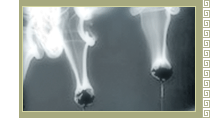Besides acupuncture, there are other modalities that are an integral part of Oriental Medicine that may be used for certain conditions or to enhance the therapeutic effects of the treatment. |
 |
Acupuncture involves the use of presterilized, single use, disposable needles inserted into various acupuncture points to remove blockages of Qi and blood. East Wind specializes in Japanese acupuncture (Kiiko style) which is a unique system based on the palpation of reflexes that both diagnoses and treats the person’s chief complaint. Other styles that may be utilized include classical Chinese acupuncture, along with the treatment of chronic myofascial pain using trigger point release techniques developed by the late Dr. Janet Travell and the founder of Tri-State College of Acupuncture, Dr. Mark Seem. These different styles of approach can address a wide variety of conditions and is tailored to treat each patient’s particular presentation.
![]()
Japanese (Kiiko style) acupuncture
Kiiko style acupuncture is a unique system created by Kiiko Matsumoto. It is a result of the synthesis of classical Chinese medicine, Kiiko’s apprenticeship with some of Japan’s greatest acupuncturists including Masters Nagano, Manaka and Kawai along with her many years of clinical experience. She has also written authoritative texts on Acupuncture and Oriental medicine and lectures extensively across the US and internationally. Kiiko style acupuncture utilizes a palpation based method designed to give instant feedback on each person’s unique presentation. Specific active reflexes that are tender to the touch suggest the diagnosis while the efficacy of the treatment is determined by significant changes in the release of these reflexes and the alleviation of pain. The palpation procedures and point selection used in this style gives the practitioner an instant measure to the effectiveness of the treatment. Both the acupuncturist and the patient will have instant feedback as to how well the treatment is working based on the release of the reflexes and the alleviation of pain. The needling techniques utilized in this style are very gentle using extremely fine gauge needles and the insertion depth is very shallow. Patients don’t even feel the needles most of the time!
This unique style also addresses the patient’s health issues from several levels. By looking more deeply into factors that often underlie a patient’s symptomatic complaints including past history, personal constitution, and/or structural imbalances, the practitioner is able to assist in a more complete and lasting healing. It is precisely this holistic approach which gives a Kiiko Style practitioner the ability to help patients with the most complex issues. Often by seeing the patient’s problem from this broader perspective, the practitioner can solve very difficult cases. Utilizing these different filters, the Kiiko practitioner can truly customize the treatment to each specific individual needs. If the reflex is not present, or if specific treatment points do not significantly change the reflex quality and/or pain, then some other more viable treatment option must be found. Both the practitioner and the patient always have some immediate indication as to the effectiveness of the treatment during each session. Patients feel better during the treatment and leave feeling much better than when they came in!
![]()
Moxabustion
Moxabustion involves the use of the Mugwort herb (Artemesia Vulgaris) to heat up an area or acupuncture point. This is very similar to heat therapy but with greater therapeutic effects from the application of an herb. Moxabustion may be applied with a moxa pole stick, placed on the needle or applied directly to an acupuncture point in order to enhance the treatment. In most cases, Moxabustion works to strengthen the blood, stimulate the flow of Qi, and maintain general health.
![]()
Cupping
Cupping is a form of suction therapy that has been used for thousands of years by many cultures. Using bamboo, plastic or glass cups, a vacuum is created by heat or suction. The cups are placed on the skin to increase warmth and bring circulation to the superficial muscle layers and a circular bruising, which is relatively painless, may appear after the treatment but will fade after a few days. Cupping helps to promote the free flow of Qi and blood, diminish swellings and reduce pain. It is commonly used for respiratory conditions, sore muscles, tension, neck pain and the common cold.
![]()
Gua Sha
Gua Sha is a traditional healing technique used throughout Asia. Gua means to rub or friction. Sha is a term used to describe congestion of blood at the surface of the body and when friction is applied in repeated strokes using a blunt instrument, the sha surfaces as small red petechiae. Sha generally disappears totally within two to four days and the color and rate of fading are both diagnostic and prognostic indicators. The benefits of Gua Sha are numerous. It moves congested blood, promoting normal circulation to the muscles, tissues and organs directly beneath the surface treated. Normal metabolic processes are restored by the movement of fluids as nutrients are carried to the tissue and metabolic wastes are carried away.
![]()
Herbal Medicine
Chinese Herbal Medicine can treat a broad range of internal disorders. It can also be a powerful adjunctive therapy to acupuncture or address internal conditions where acupuncture may not be as effective. Various herbs are combined into a formula by using the most effective combinations of herbs that target each individual presentation. These formulas have the capacity to address the root cause of various conditions and can treat acute or chronic disorders. The formulas can be prescribed in a number of ways by using raw herbs boiled into a tea, liquid extracts, pills, powders or poultices. Herbal medicinals can be used to expedite the healing process, strengthen, support and tonify the body.
An Herbal formula can be recommended if your condition warrants the use of herbs
East Wind Healing Arts
50 Lexington Ave, Suite LL3
New York, NY 10010
(917) 650 – 2801
info@eastwindhealingarts.com
See Map To Office